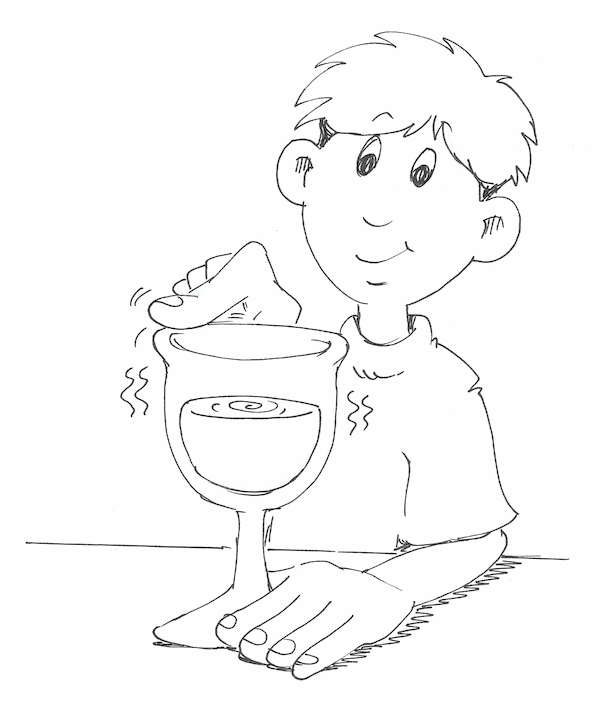Splish, Splash - Spouting Glass

Everyone loves our Chinese Spouting Bowl, which we often demonstrate at our public events (see the video below). By wetting your hands and rubbing the handles of the bowl back and forth slowly, waves will form and grow in the water until it splashes from 4 or more locations around the rim, often more than a foot in the air! Unfortunately most of you probably don't have your own spouting bowl, but now you can reproduce this cool demonstration at home with an ordinary wine glass.
What you'll need:
- A wine glass (the kind with a stem, crystal is better, but even cheap wine glasses usually work well)
- Water
Also be sure to ask your mom, dad or another adult to help-especially if you're using their good glasses!
Experimental Procedure (watch the video below):
- Fill the glass with water, about an inch from the top is fine.
- Wash your hands with soap and water (your hands should not be greasy)
- Dip your index finger in the water and thoroughly wet the rim of the glass.
- Press your wet index finger on the rim of the glass and rub back and forth (you're trying to make that "squeaky clean" sound).
- Watch the surface of the water closely. You should see wave patterns begin to develop.
- Once you see the wave patterns form, rub a little harder and the waves should grow larger, eventually splashing tiny droplets of water into the air from 4 or more locations around the glass.
- Notice that as you move your finger further around the rim of the glass the wave patterns seem to follow your finger.
What's Happening:
Objects can be made to vibrate by forcing them to move back and forth quickly. A dry finger will stick to the rim of a wine glass pretty well, but when you wet your finger a little, it will begin to slide. Either way, when you rub the rim of the wine glass in just the right way, your finger will stick for a short time, then slide a little, then stick again, then slide again, etc. (the same thing happens as you rub the handles of the spouting bowl with your wet hands). This is called "stick-slip" friction, and in a sense it's like tapping on the rim of the glass (or bowl) very quickly. This makes the glass begin to move back and forth or vibrate, literally bulging in and out at various places around the rim and at many different speeds. The number of times the rim vibrates back and forth per second is called the frequency, and many different vibration frequencies are excited as you rub the rim of the glass. These movements are much to small in magnitude and much too fast to see with your eyes, but we can easily see the waves that are created by the rim pushing on the water in the glass.
Since these vibrations are so small, most of them lose their energy and die out very quickly. Any solid object, however, has a set of special frequencies (and shapes) at which it prefers to vibrate, called its natural or resonant frequencies (and modal shapes). At these resonant frequencies it takes only a very small amount of input motion or energy to produce very large vibrations and large output energies. As you start the wine glass or spouting bowl vibrating with your stick-slip motion, these resonant frequencies are also excited, but since they require only a small input energy to produce large output vibrations, they quickly dominate the motion and last much longer. This is called resonance, and we say the object is resonating. The sound you hear is produced by the resonant vibration of the glass or bowl.
Now back to the waves in the water. The large vibrations along the rim of the glass push on the water, sending waves traveling across the surface. When the waves hit the other side of the glass they bounce back (reflections) and run into other waves traveling in the opposite direction. All of these waves, which are being launched at precise time intervals, begin to combine. In places where two or more wave crests or high points meet, the combined wave will be even higher. Similarly, in places where two or more wave troughs or low points meet, the combined wave will be even lower. In other places crests and troughs from different waves will meet and cancel each other. This creates what are called standing wave patterns (i.e. the combined wave pattern appears to stand still) on the surface of the water. FInally, because the standing wave patterns are created by large resonant vibrations of the glass (or bowl), the standing water waves become very large also, eventually splashing water high into the air. The locations where the water splashes highest corresponds to locations where the glass (or bowl) is moving the most, called anti-nodes. Halfway between each anti-node is a node, a location where the rim of the glass (or bowl) is not moving at all. Near these nodes the standing waves are very small and no splashing occurs. Since the position of the handles are fixed on the spouting bowl, the positions of the nodes and anti-nodes are also fixed, and the water always splashes in the same locations, For the wine glass, however, your finger is moving around the rim, thus the vibrations of the rim as well as the standing wave patterns in the water also move with your finger.
Variations and Related Activities:
Coming soon.
Links to more information and activities
Buy your own Chinese Spouting Bowl:
http://www.teachersource.com/product/chinese-spouting-bowl/sound-waves
http://www.kleinbottle.com/SpoutingBowls.htm
(be sure to check out the rest of this website- it's very funny, if you're a nerd!)
|